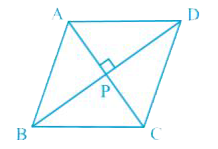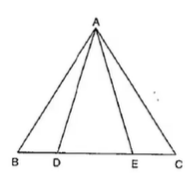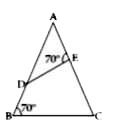In Fig. 2.39
(a) What is AE+EC ?
(b) What is AC−EC ?
(c ) What is BD−BE ?
(d) What is BD−DE ?

Video Solution
|
Answer
Step by step video & image solution for In Fig. 2.39 (a) What is AE+EC ? (b) What is AC-EC ? (c ) What is BD-BE ? (d) What is BD-DE ? by Maths experts to help you in doubts & scoring excellent marks in Class 6 exams.
Updated on:21/07/2023Topper's Solved these Questions
- GEOMETRYBOOK - NCERT EXEMPLARCHAPTER - GEOMETRYEXERCISE - Exercise (State whether the statements given in questions are true (T) or false (F):)
10 Videos
- FRACTIONS AND DECIMALS BOOK - NCERT EXEMPLARCHAPTER - FRACTIONS AND DECIMALS EXERCISE - ACTIVITY
1 Videos
- INTEGERS BOOK - NCERT EXEMPLARCHAPTER - INTEGERS EXERCISE - Exercise
42 Videos
Similar Questions
Knowledge Check
What does ECS in banking transactions stand for?
AExcess Credit SupervisorBExtra Cash StatusCExchange Clearing SlandardDElectronic Clearing ServiceIn ΔABC, AD and AE are bisectors of ∠BAC and ∠BAD respectively. If ∠BAE=30∘, AE = 9 cm and EC = 15 cm, what is the area (in cm2) of ΔAEC ?
A36B54C72D216The middle point of A (1, 2) and B (x, y) is C (2, 4). If BD is perpendicular to AB such that CD = 3 unit, then what is the length BD ?
A2√2 unitB2 unitC3 unitD3√2 unit
In Fig. 2.2, if AC⊥BD, then name all the right angles.

View SolutionIn the given figure , if AD = 12 cm , AE = 8 cm and EC = 14 cm , then what is the value (in cm ) of BD ?

View SolutionIn Figure, AD=AE and D and E are points on BC such that BD=EC. Prove that AB=AC

View SolutionIn Fig. 30 D and E are to points on BC such that BD=DE=EC. Show that ar(ABD)=ar(ADE)=ar(AEC).
View SolutionIn a triangle ABC, if a=5,b=4andc=3,DandE are the points on BC such that BD=DE=EC. If ΔDAE=θ, then tanθ=
View Solution

